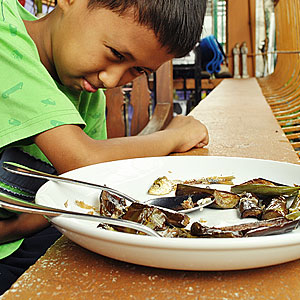In a small town in San Pedro, Laguna over 200 residents displaced by typhoon Ondoy ate their early dinner after a church meeting. The packed meals donated by the Christian Bible Baptist Church (CBBC), contained a serving of delicious chicken adobo and hardboiled eggs with rice. Hours later, 212 of those who consumed the donated meal were rushed to various hospitals after showing signs of food poisoning: dizziness, vomiting, and loose bowel movement. No fatality was reported.
Feeding Nightmares
Incidents like these are not as prevalent as one might assume considering that Filipinos rarely practice food safety measures, as witnessed by Gerard Alo, an Ace and Associates senior staff managing the security and safety department of a premier hotel. Alo, who has worked with several major companies establishing safety and security programs to comply with international standard Hazard Analysis Critical Control Points (HACCP), points out that safety measures in the food industry are not being carried out proficiently because the people (food prep staff, chefs, etc.) who need to implement such are the ones who actually violate it. This is disturbing, to say the least.
“What is needed is a behavior-based safety program. Most Filipinos like short-cuts—we do it for compliance and not for safety’s sake,” says Alo of food safety measures in place. The safety and security professional adds, “It’s difficult to implement a safety program unless you have a behavior-based safety program. In advanced countries, they assign someone at the beginning of the day to observe unsafe acts in kitchens—a safety observer. A person is immediately corrected and provided immediate feedback on his unsafe act, why it is unsafe and what is the proper way. Behavior-based safety is new in the Philippines. The only ones that observe them now are the petrochem companies because these are highly hazardous work places.”
In mass feeding scenarios, the percentage of food-related diseases in evacuation centers in October 2009 during Ondoy was only at 14% (acute gastroenteritis). The study conducted by the National Epidemiology Center indicated a higher percentage of acute respiratory illnesses at 54% with skin infection at 18%. There were more cases of leptospirosis than food poisoning. However, in a Department of Health (DOH) investigation, from 1993 to 2002, Food and Waterborne Diseases (FWBDs) like cholera, typhoid fever, hepatitis A, and other food poisoning-related diseases were reportedly the most common outbreaks. Establishing the Food and Waterborne Disease Prevention and Control Program (FWBDPCP) in 1997, the DOH aims to focus on education and strict food and water sanitation.
When Food Attacks
Food going bad on us is not just related to stormy weather. Food also goes bad, according to the DOH, when the summer months really sizzle. When it’s too hot, meals are susceptible to bacterial attack, which may lead to food poisoning. For the past 20 years, diarrhea has been a leading cause of death in the country, and 70% of diarrheal cases have been attributed to ingestion of contaminated food or water.
In its most insidious form, food has been used as a weapon. Bioterrorism is not just about spreading anthrax or nerve gas. In 1994, a Buddhist cult called Rajneeshee concocted a medley of salmonella and sprinkled the deadly bits on the salad bar of Shakey’s in Oregon, and in ten other local restaurants, these loose religious fanatics contaminated table-top coffee creamers, potato salads, and drinking water. The goal was to get as many people infected so they would be too sick to vote, allowing the Rajneeshee to control the election by reportedly using imported homeless people to vote (“America’s First Bioterrorism Attack by Philip Elmer-Dewitt,” Time Magazine, September 30, 2001). No one died but 751 fell seriously sick.
In a calamity aftermath, food in affected areas may be contaminated and cause food-borne outbreaks. But the DOH has observed, especially in isolated and poorer regions, that these outbreaks can occur even without a calamity. According to a 2006 USAID finding, 12 Filipinos die of dirty water every day. Most communities still do not have access to potable water and are virtually without sanitation facilities. So even without a disaster, conditions unfortunately are already brewing for a food-borne outbreak.
Alo says it may take a long while before proper attention and action is paid to food sanitation; some industries have only begun to establish food safety guideline in the last five years. While the government should maintain support for food safety and be ahead of any new food-borne risks produced by disasters, you as an individual have a responsibility, too. Washing your hands after you’ve been to the bathroom is just one of many ways you can protect yourself, your family, and others around you. Remember, there is a reason why food is marked as “perishable.”
RESPONSE TO FOODBORNE OUTBREAKS
From the World Health Organization
Early detection is crucial. Indications that should prompt an investigation include:
- Reports from health workers of foodborne disease symptoms
- Reports from pharmacists of an unusual demand for anti-diarrheal agents or other medication for gastrointestinal problem
- Reports of unusual death, absenteeism from schools and the workplace especially in large industries
Investigation of and response to a suspected food safety emergency involves:
- Timely treatment of exposed people
- Removal (recall) of the contaminated food from circulation to be coordinated by the national food safety agency in collaboration with the food industry and other food providers.
- Rapid identification of the causative agent and the suspected food by patient interviews and by appropriate diagnostic laboratory testing
- Epidemiological investigation to identify the causative agent, the responsible food and the manner of contamination including: collection, transport and processing of samples.
- Collation of information about sources of contamination and coordination with law enforcement, food safety regulatory authorities, industry, emergency medical response agencies, and (when imported food may be involved) quarantine and customs agencies (swift communication among all these entities is essential)
- Timely provision of information to the public on food-related risks and the actions they should take to minimize those risks; the information must be conveyed in a manner that is culturally appropriate and does not cause unnecessary anxiety






